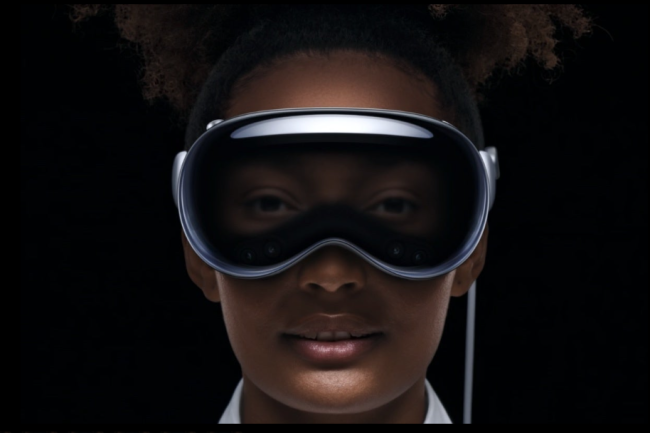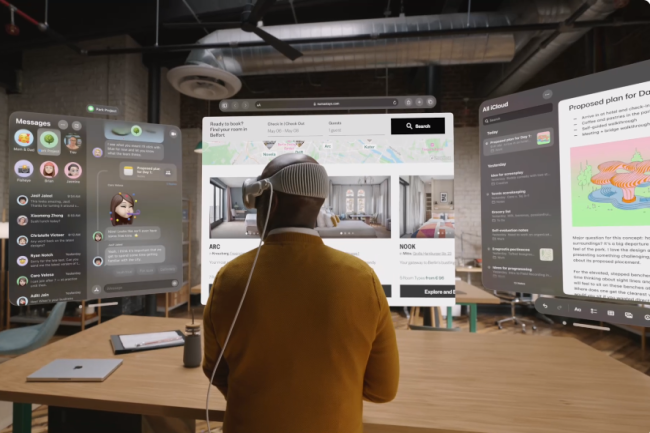WWDC 2023: the Vision Pro helmet, a reality that is still too virtual

Apple has finally presented its mixed reality headset. Named Vision Pro, it will be available in 2024 in the United States for an announced price of 3,500 dollars excluding VAT. If the technical characteristics bode well for good performance, it remains to find its place on a market that is still looking for itself.
It was undoubtedly the most anticipated announcement of the Apple developers conference: the virtual reality headset. Tim Cook waited until the end of the event to lift the veil on this equipment called Vision Pro and not Reality Pro as several analysts predicted. It should be marketed in the spring of 2024, in the United States at first, for a price of 3,500 dollars excluding VAT. A price to put into perspective with other existing helmets such as the recent announcement of Meta and its Quest 3 at 500 dollars excluding VAT.
The R1 chip takes its first steps
What is hidden behind the Vision Pro to justify such a price? Tim Cook talks about “a new type of computer”. On the technical side, the helmet with a design very similar to a ski mask includes the firm’s M2 chip supported by the R1 chip used to process data from twelve cameras, five sensors and six microphones. The objective is to reduce latency as much as possible. We will have to wait a little longer to learn a little more about the technical characteristics of this R1 chip. On the screen side, it is equipped with two micro-Oled panels displaying 23 million pixels. The videos can be rendered with a resolution of 4K and the text appears sharp regardless of the angle of view. For the audio aspect, the headset has two individually amplified speakers, capable of providing a personalized spatial sound according to the shape of the user’s head and ears. Thus, the sound seems to come from the space that surrounds you. Vision Pro also adapts the sound to the room thanks to ray tracing audio.

The Vision Pro includes a battery to improve the autonomy of the mask. (Photo Credit: Apple)
Inside the lenses, an eye tracking system relies on the cameras and an LED ring to project invisible light patterns on the user’s eyes. The headset is thus able to determine the direction of the user’s gaze and manage the interface. The eye, and in particular the iris, is also used to unlock the terminal, authenticate or pay for purchases on the App Store via the method called Optic ID. Finally, in order not to be isolated from the rest of the world, Apple has introduced the EyesSight function which makes the user’s eyes visible to those around them. Finally, note that a battery pack can be connected to the mask to increase its autonomy.
A dedicated OS and the first applications
As for the other terminals of the brand, Apple has developed an operating system specific to the Vision Pro. Called visionOS, it is optimized for mixed reality experiences. The Cupertino firm will offer tools, such as Xcode IDE, for developers to create applications for the headset. While waiting for the creativity of programmers, Apple specifies that many applications will be available from launch, including games, Microsoft Office Apps, third-party video conferencing applications and Adobe Lightroom. He also presented a preview of a SkyGuide application capable of immersing you in space.

Apple presented examples of using the Vision Pro and the various expected applications. (Photo Credit: Apple)
Among the applications that are expected to start, there is FaceTime to do video conferencing. The app will be able to take advantage of the room that surrounds you so that you can see your interlocutors in real-sized tiles. The participant’s voice will also be heard in the direction of his tile thanks to the Spatial Audio function. During a FaceTime call, users wearing Vision Pro are represented by a Persona – an avatar generated and controlled by AI. In its presentation, Apple bets a lot on entertainment with immersive experiences in movies or series. The firm has entered into a partnership with Disney+ to develop content dedicated to this platform.
A market in search of success
By deciding to go to the mixed reality market, Apple is trying an ambitious bet. Indeed, at the end of 2022, this sector was taking a step back with sales of VR headsets worldwide falling by 12% to 9.6 million units. Recently, Mark Zuckerberg, Meta boss admitted that his ambition in the metaverse would take longer than expected. In 2023, the recent announcements of Meta on the Quest 3 or Sony with the Playstation VR 2 (sold more than 600,000 copies) should breathe new life into the consumer market.
With a price of 3,500 dollars excluding VAT, Apple’s Vision Pro is moving away from this target to get closer to Microsoft’s Hololens 2 (available from 3,849 euros excluding VAT) which are developing within companies and administrations (such as the US army). It will therefore be necessary to wait until 2024 to find out if the Vision Pro graft enters the market or if a refocusing towards professional use will be carried out.








